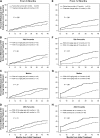Failure-free survival after initial systemic treatment of chronic graft-versus-host disease
- PMID: 24876566
- PMCID: PMC4141518
- DOI: 10.1182/blood-2014-03-563544
Failure-free survival after initial systemic treatment of chronic graft-versus-host disease
Abstract
This study was designed to characterize failure-free survival (FFS) as a novel end point for clinical trials of chronic graft-versus-host disease (GVHD). The study cohort included 400 consecutive patients who received initial systemic treatment of chronic GVHD at our center. FFS was defined by the absence of second-line treatment, nonrelapse mortality, and recurrent malignancy during initial treatment. The FFS rate was 68% at 6 months and 54% at 12 months after initial treatment. Multivariate analysis identified 4 risk factors associated with treatment failure: time interval <12 months from transplantation to initial treatment, patient age ≥60 years, severe involvement of the gastrointestinal tract, liver, or lungs, and Karnofsky score <80% at initial treatment. Initial steroid doses and the type of initial treatment were not associated with risk of treatment failure. Lower steroid doses after 12 months of initial treatment were associated with long-term success in withdrawing all systemic treatment. FFS offers a potentially useful basis for interpreting results of initial treatment of chronic GVHD. Incorporation of steroid doses at 12 months would increase clinical benefit associated with the end point. Studies using FFS as the primary end point should measure changes in GVHD-related symptoms, activity, damage, and disability as secondary end points.
© 2014 by The American Society of Hematology.
Figures



Comment in
-
FFS: an end(point) to our problems in chronic GVHD trials?Blood. 2014 Aug 21;124(8):1216-7. doi: 10.1182/blood-2014-06-579672. Blood. 2014. PMID: 25147381 Free PMC article.
References
-
- Lee SJ, Vogelsang G, Flowers ME. Chronic graft-versus-host disease. Biol Blood Marrow Transplant. 2003;9(4):215–233. - PubMed
-
- Socié G, Schmoor C, Bethge WA, et al. ATG-Fresenius Trial Group. Chronic graft-versus-host disease: long-term results from a randomized trial on graft-versus-host disease prophylaxis with or without anti-T-cell globulin ATG-Fresenius. Blood. 2011;117(23):6375–6382. - PubMed
-
- Stewart BL, Storer B, Storek J, et al. Duration of immunosuppressive treatment for chronic graft-versus-host disease. Blood. 2004;104(12):3501–3506. - PubMed
Publication types
MeSH terms
Substances
Grants and funding
LinkOut - more resources
Full Text Sources
Other Literature Sources

